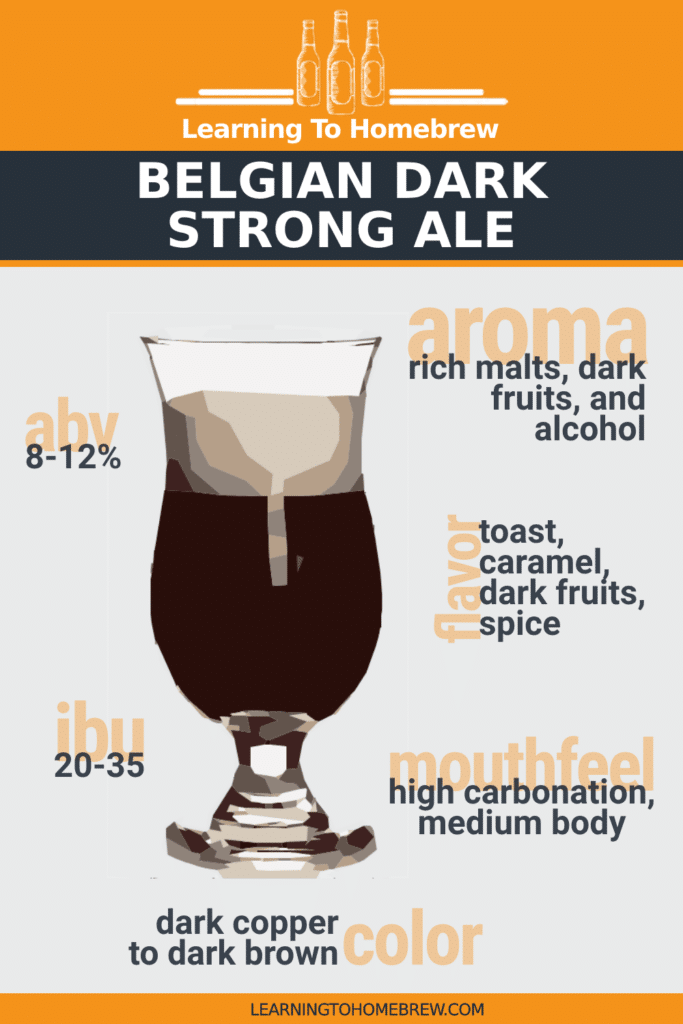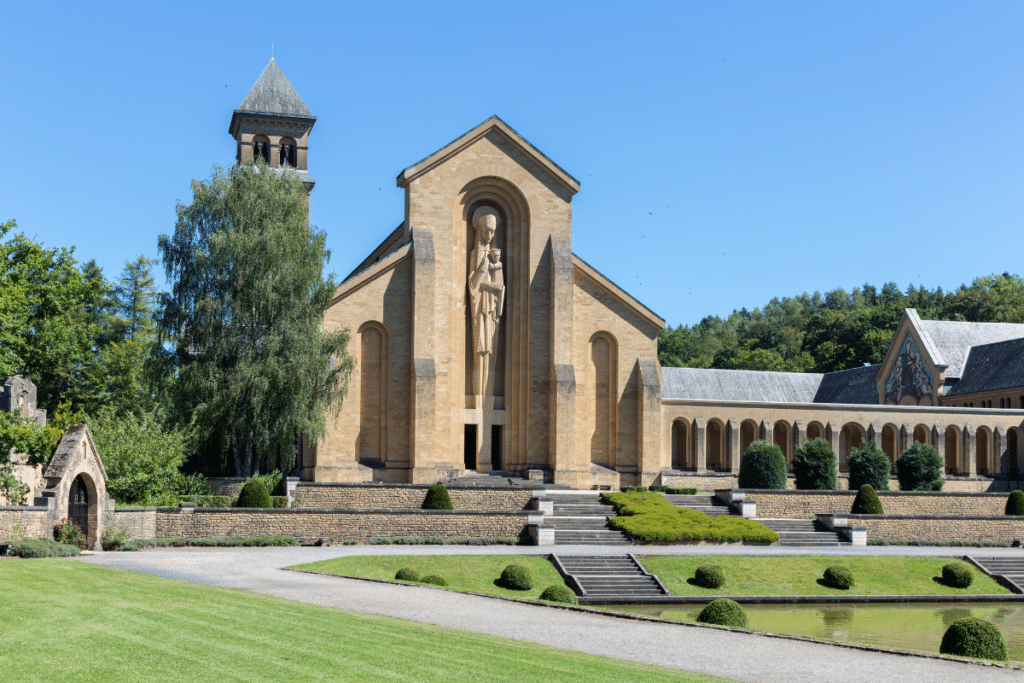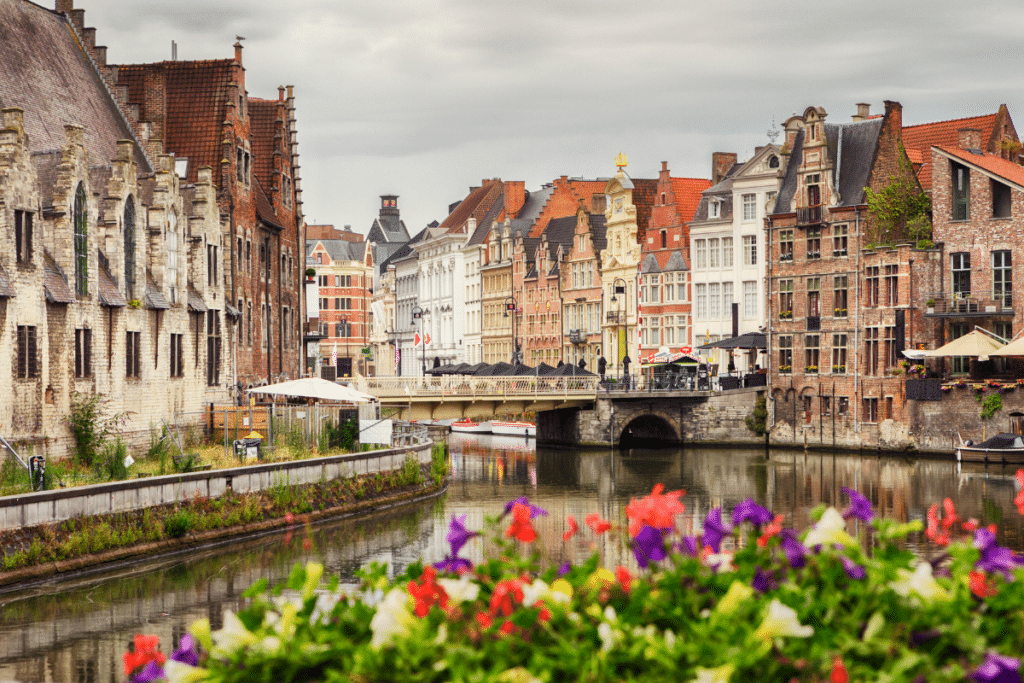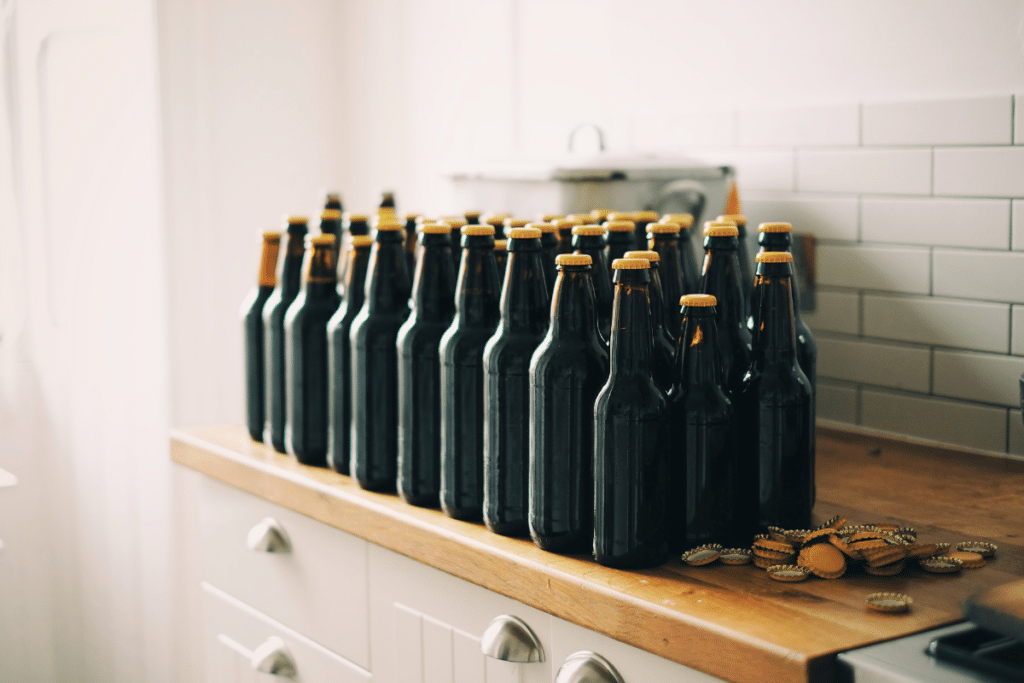Once you have a few brews under your belt you may be looking for a more challenging beer style. Like many Trappist beers, the Belgian dark strong ale offers a complex flavor profile to aim for.
Brew an impressive Belgian dark strong ale with hard water balanced between chlorides and sulfates. Start with Belgian Pale Ale or Pilsner malts for your base. Add specialty grains such as Special B or aromatic. Pick a yeast strain that has high attenuation, medium to high flocculation, medium to high ester production, and high alcohol tolerance.
Keep reading to learn all about the ingredients and brewing process for a Belgian dark strong ale.
Topics We Cover
What is a Belgian dark strong ale?
While the name may imply it is a beer akin to motor oil, the Belgian dark strong ale (also known as a Belgian Quadrupel) is actually very appealing.
The Belgian dark strong ale is a complex ale with rich malt flavors balanced by bitterness and fruity esters. With an ABV between 8% and 12%, this beer style presents bold flavors to accompany its strong alcohol presence.
It is a dark coppery to deep brown color and has a thick cream-colored head when poured.
When it comes to the aroma and flavors, they are quite similar. With most Belgian Dark Strongs you will taste toasted bread and dark caramel malt flavors but it shouldn’t dip too deep into the darker malt flavors.
The flavor profile does allow hop bitterness, esters, and some hop flavors. The bitterness can be as strong as the malt flavors though this isn’t as common. Usually, the hop character, both bitterness and flavors, are secondary to the malts and dark fruit esters.
A Belgian dark strong can be somewhat sweet but shouldn’t be overly so. More typically it is a drier beer. Overall, it should be an enjoyable beer with some great depth of flavor.

Defining characteristics of Belgian dark strong ales include:
- Color – 12-22 SRM (dark copper to deep brown)
- Common flavors – Toast, caramel, dark fruits, spice
- Aroma – Rich malts, dark fruits, alcohol notes
- Mouthfeel – High carbonation, medium body, alcohol warmth
- IBUs (Bitterness) – 20-35
- ABV – 8-12%
History of the Belgian dark strong ale
Belgian dark strong ales were first brewed in the early 1800s. This is a time when Belgium became independent and brewing techniques were advancing. Monasteries in Belgium were brewing dark ales with strong alcohol and flavors present.
These early Belgian Quads were likely different than what we think of today. However, they were the beginnings of the style. It wasn’t until the mid-1900s that the Belgian Monasteries began brewing what modern beer enthusiasts would recognize as a Belgian dark strong ale.

Eventually, this style came over to the U.S. and was swept up in the craft beer movement of the late 1900s. The American craft brewers did what they do and put an American spin on the beer.
Traditional examples of the style have some measure of maturity when it comes to the character. American craft examples tend to be more bold and can feature all manner of additions.
Popular commercial Belgian dark strong ales
For the beer enthusiasts and the beer curious here’s a quick list of Belgian dark strong ales you should try.
- Bières de Chimay Bleue – This French example of the style has a depth of flavor you have to try to believe. Try this beer to enjoy fruity flavors balanced by toasty bread flavors.
- Brasserie de Rochefort Trappistes Rochefort 8 – This Belgian Quad is a typical example of the style with strong bread flavors, fruits such as plums, and peppery spices.
- Unibroue Trois Pistoles – Characterized by rich bread flavors, this beer brings dark fruits to center stage. It is sweet but not too sweet with a dry finish.
- Dogfish Head Craft Brewery Raison D’Être – An American version of the style with all the right notes. This beer is dry with slightly subdued dark fruit flavors and a complex malt profile.
How to brew a Belgian dark strong ale
Once you’ve explored some great examples of a Belgian dark strong ale you may be thinking of how to brew your own. In order to brew the best beer you need to know the style forward and backward. To that end, I will break down everything you need to know.
Start with hard water that strikes an even balance between chlorides and sulfates. Unsurprisingly, you’ll want to use a Belgian Pale Ale malt or Pilsner malts for your base. Use specialty grains such as Special B or aromatic. Pick a yeast strain that has high attenuation, medium to high flocculation, medium to high ester production, and high alcohol tolerance.
Let’s start by going over some great choices for the recipe and ingredients. Then, we can look at the process including brew day, fermentation, and bottling.
Recipe and ingredients
While you can’t have beer without fermentation, you can’t get anywhere without quality ingredients. There are of course no wrong ingredients, but some will go together much better than others.
The recipes for this style typically use the same ingredients with some variation here and there:
- Water profile
- Base grains
- Specialty grains or other additions
- Hops
- Yeast
As always, start with your water. Since beer is nearly 90% water, good water makes good beer. Then consider your grain bill, hops, and finally yeast. Each one can have a significant impact on your final product.
Water profile

The best water profile for a Belgian dark strong ale has a nearly balanced chloride-to-sulfate ratio. As a darker beer, you may need to adjust for the pH drop that comes with dark malts. Raise the alkalinity slightly with some calcium carbonate.
Sulfates in the water profile add to the hop characteristics and overall bitterness. Chlorides on the other hand enhance malt flavors. Sulfates are great in beers like this to dry the finish and offset the sweetness of the malts or residual sugars.
Alternatively, you can lean slightly towards chlorides to further enhance the malt flavors. Keep in mind that low concentrations of either (20 ppm or lower) can be difficult to perceive.
As for the pH, the exact interval you’ll need to raise the alkalinity by will depend on your grain bill. Use a brewing water calculator to determine the exact levels you need to offset the dark malts in your grist.
Base grains
Most of your complexity will come from your specialty grains and other additions. The base malt you choose is up to personal preference. Both Pilsner and Pale Ale are great choices as they provide a quality foundation.
In a Belgian dark strong ale, use a Pilsner or Pale Ale malt for the base. Use Belgian variations for the most traditional approach.
Choose Pilsner if you want a little more cracker flavors. Pale Ale malt will be more toasty. Both belong in a Belgian dark strong.
Specialty grains or other additions
A Belgian dark strong ale calls for specialty grains with a little extra character without being too roasted.
Great choices include Belgian Special B, aromatic, and CaraMunich malts. Additionally, make use of candi syrups to add specific flavors and color.
Special B is primarily used to add a raisin and dark caramel notes but beware of using too much as it can affect the body. Aromatic malts are great for complex malt flavors. Lastly, CaraMunich malts are perfect for more caramel flavor and biscuity notes.
The common Candi sugar choices include Belgian D-180 and D-90. The D-180 adds dark fruit, toffee, and rich malt flavors. The D-90 adds similar flavors but to a lesser extent. Go with the lighter or heavier version depending on what specialty grains you use.
Hops
A Belgian dark strong ale uses hops for the bitterness first and foremost. Any flavor or aroma should not be very pronounced if present at all. German noble hops are preferred.
If you choose to add any hop flavor or aroma, be sure to use hops that provide spice, herbal, or floral notes. These are the most acceptable in this style.
You may also be interested in: Why are hops added at different times?
Bittering
Bittering hops added early in the boil will go through a process called isomerization. This is what gives a beer its bitterness.
A Belgian dark strong ale calls for anywhere from 20 to 35 IBUs. For convenience, use higher alpha acid concentration varieties for bittering.
Here are some good choices for bittering hops.
| Name | Purpose | Alpha Acid % |
|---|---|---|
| Magnum | Bittering | 12-14 |
| Warrior | Bittering | 15-18 |
| Chinook | Bittering + Aroma | 12-14 |
| Northern Brewer | Bittering + Aroma | 5-10 |
Aroma and flavor
Aroma and flavor hops added towards the end of the boil don’t add much bitterness. Instead, they add oils that provide flavor and aroma. Noble German hops are best here.
Here are a few good choices to get you started.
| Name | Flavor/Aroma | Alpha Acid % |
|---|---|---|
| Saaz | Floral, Spicy, herbal, woody | 2.5-4.5 |
| Styrian Goldings | Spicy, woody, citrus | 4-6.5 |
| Hallertau Mittelfruh | Herbal, woody, floral | 3-5 |
| Tettnanger | Floral, citrus, woody | 2.5-5.5 |
Yeast
The yeast used adds a lot of the identifying characteristics to this style.
A Belgian dark strong ale calls for a yeast strain that has high attenuation, high flocculation, medium to high ester production, and high alcohol tolerance.
Look for yeasts that produce dark fruit esters in particular. The phenols produced are also important. They should provide some spice–typically peppery. The best yeasts for this are ones from Belgium.
Dry
Below are some good dry yeast options for a Belgian dark strong ale.
| Name | Attenuation | Flocculation | Temperature Range | Alcohol Tolerance (ABV) |
|---|---|---|---|---|
| Safbrew BE-256 | 82-86% | High | 64.4-78.8°F | 9-11% |
| Mangrove Jack M41 | 82-92% | Medium | 64-82°F | High |
| LalBrew Abbaye | 88%~ | Medium – High | 63-77°F | High |
Liquid
Below are some good liquid yeast options for a Belgian dark strong ale.
| Name | Attenuation | Flocculation | Temperature Range | Alcohol Tolerance (ABV) |
|---|---|---|---|---|
| Wyeast 3787 | 74-78% | Medium | 64-78°F | 11-12% |
| WLP530 | 75-80% | Medium – High | 66-72°F | 8-12% |
| Wyeast 1762 | 73-77% | Medium | 65-75°F | 12% |
Brewing process
After acquiring all of your ingredients, you can move on to brew day. What you do on brew day can have just as much impact on your results as your choices of ingredients. On brew day, one of the most important aspects is sanitization. Be thorough when sanitizing.
All grain, partial, and extract brewing each have important considerations for you to make. When doing all grain or partial brewing you need to consider mashing and sparging. From there the other considerations are similar. The boil step and on is the same for all three.
Let’s break down each step with the Belgian dark strong ale in mind.
Mashing
For a Belgian dark strong ale, your mash temperature should be between 148°F and 152°F. Mash for at least 1 hour. The lower end of this range will produce drier beers. The higher end will be a little more sweet but should still be fairly dry.
Lower mash temperatures like the lower end of the above range are great for high-strength beers. This temperature range should ensure all of the sugars are easily digestible for your yeast.
You can also perform a step mash for greater control. This may not be worthwhile in many beer styles but it certainly is for a Belgian strong dark. Include protein, beta, and alpha rests. The overall mash should be about two hours. The longest rest should be the beta rest.
Boil
The boil for a Belgian dark strong ale should be an hour long. Most of your hop additions will be in the first 30 minutes for bittering. Many recipes will also call for a late hop addition or two for aroma and flavor.
The hop addition times are heavily dependent on the amount, alpha acid concentration, and purpose. Since this style calls more for bittering hops you won’t be adding much to the late boil.
Some homebrewers use fining agents in the last few minutes of the boil. If haze is not a concern, you won’t need any. Additionally, if you did a protein rest during your mash (if applicable), you won’t have to worry about haze as much.
Whirlpool or flameout
Boil aside, there are other times to add hops. They aren’t strictly necessary but can be great for adding flavor and aroma.
Adding hops during flameout can be a great way to get the flavors and almost no bitterness. This is done directly after the boil and before you pitch yeast. As you transfer to your fermentor, create a whirlpool as you drain the boiling vessel. You typically won’t need a flameout addition in a Belgian dark strong ale.
This is only possible when you have a vessel that can drain from the bottom. Whirlpooling can also be a great way to collect the trub in the middle and reduce the amount that gets in your fermentor.
Fermentation
As always, fermentation is crucial but mostly hands-off.
Keeping the fermentation temperature consistent aside from deliberate step-ups is crucial for quality beer. Be sure to avoid direct sunlight and keep the temps in the mid-range for a Belgian dark strong ale.
Keeping the fermentation at a consistent temperature will help keep your brew clean from fermentation byproducts. You may want to let the temperature rise slightly later on in fermentation to promote those fruity esters.
Temperatures
While the temperatures are yeast dependent there is a rough range you should keep your Belgian dark strong ale near. Try to keep your fermentor around 65-70°F for the entirety of the process.
This beer style benefits from some gentle temperature increases during fermentation. Start low, around 64°F or 66°F, then increase by a degree every few days. Be sure to stop at 70°F as any higher will result in a harsh alcohol presence.
If you miss your temp goals by a few degrees or can’t keep it consistent it won’t be the end of the world so long as it doesn’t get too high. This level of micromanaging is great for elevating your final product but isn’t essential.
Bottling or kegging
The debate between bottling and kegging will go on for as long as brewers have a choice. It is generally up to personal preference and setup.

Belgian brewers typically bottle condition Belgian dark strong ales. Kegging will allow you to bulk condition while bottles can make it easier to save portions for aging. This can be great since it allows you to taste it as it ages.
Belgian dark strong ale recipes
If you aren’t one to create your own recipes here are a few that you can follow for great results. These recipes are from various brewers as credited below.
- Rochefort 10 clone (All Grain)
- Belgian Quad (All Grain)
- Belgian Dark Strong Ale I (Extract)
Rochefort 10 clone (All Grain)
This recipe comes from user mackeydj on Brewer’s Friend.
Ingredients
- US Pale 2-row – 5 lb
- UK Maris Otter Pale – 3 lb
- Belgian CaraMunich – 1.5 lb
- Belgian CaraVienne – 1.5 lb
- Flaked Wheat – 1 lb
- Belgian Aromatic – 0.5 lb
- Belgian Special B – 0.25 lb
- Date Sugar – 0.69 lb
- Brown Sugar – 1 lb
- Clear Candi Sugar – 1 lb
- Dark Candi Sugar – 1 lb
- Dark Rock Candi Syrup – 1 lb
- Turbinado Sugar – 1 lb
- Kent Goldings Hops – 1 oz
- Hallertau Hersbrucker Hops – 2 oz
- Coriander Seed – 5 g
- Servomyces Yeast Nutrient
- Yeast Nutrient
- Wyeast 1762
Method
- Heat 6.5 gallons to 135°F.
- Add grain bill and rest for 30 minutes.
- Raise the temperature to 165°F and rest for 30 minutes.
- Raise the temperature to 172°F and rest for 15 minutes.
- Mashout.
- Let cool until the temperature is 140°F then rest for 30 minutes.
- Collect 7.25 gallons of wort.
- Boil for 90 minutes.
- At 50 minutes left add the Kent Goldings and 1.5 oz of the Hallertau.
- At 25 minutes left add the rest of the Hallertau.
- At 15 minutes left add the date sugar, brown sugar, Candi sugar, Dark Rock Candi Syrup, turbinado sugar, Coriander seed, and the yeast nutrients.
- Flameout then transfer to the fermentor.
- Cool and pitch yeast.
- Maintain 65°F during fermentation. Perform temperature raises in steps as desired.
- Rack to keg or bottles after a week or two. Age for at least 6 months. Enjoy!
Belgian Quad (All Grain)
This recipe comes from user ScottP on Brewer’s Friend.
Ingredients
- Belgian Pale Ale – 9 lb
- Belgian Pilsner – 6 lb
- German Vienna – 3 lb
- Candi Syrup D-180 – 2 lb
- Brewer’s Gold Hops – 2 oz
- WLP550
Method
- Heat 7 gallons to 150°F.
- Add grain bill and mash for 1 hour.
- Mashout.
- Collect 7.5 gallons of wort.
- Boil for 90 minutes. Add 1 oz of the hops at the beginning.
- At 15 minutes left add another 0.5 oz of the hops.
- At 5 minutes left add the rest of the hops.
- Flameout then transfer to the fermentor.
- Cool and pitch yeast.
- Maintain 68° F during fermentation.
- After fermentation, rack to keg or bottles. Age for at least 6 months. Enjoy!
Belgian Dark Strong Ale I (Extract)
This recipe comes from user MartyWayne on Brewer’s Friend.
Ingredients
- DME Pilsen – 8 lb
- Dark Belgian Candi Sugar – 1 lb
- US Caramel 60° L – 2 lb
- US Victory – 0.5 lb
- Belgian Special B – 0.5 lb
- UK Amber – 0.5 lb
- Warrior Hops – 1 oz
- Hersbrucker Hops – 1 oz
- Irish Moss – 2 tbsp
- Wyeast 1214
Method
- Heat 3 gallons of water for your boil.
- Add the steeping grains when the water is around 140°F.
- Steep for roughly 20 minutes.
- Remove the grains when the water is around 170°F.
- When a boil is reached, add the malt extract and the Candi sugar.
- Boil for 60 minutes. Add the Warrior hops right away.
- At 15 minutes left, add the Irish Moss.
- At 5 minutes left, add the Hersbrucker.
- Flameout and transfer to the fermentor.
- Cool and pitch yeast.
- Maintain 68°F during fermentation.
- After a week or so, rack to keg and force carbonate or bottle condition. Age for at least 6 months.

